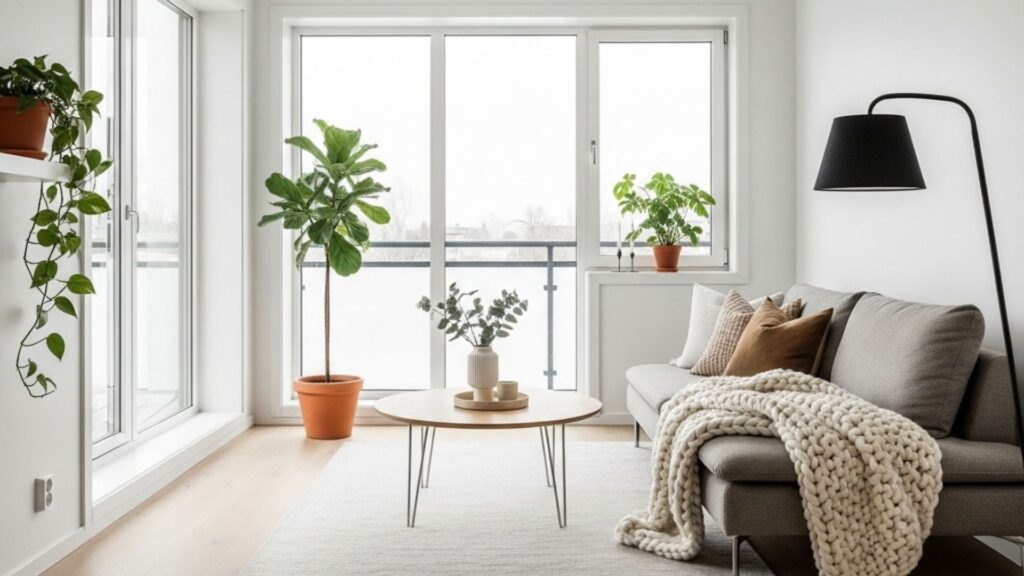Designing a home that reflects simplicity, comfort, and functionality can be challenging in today’s fast-paced world. Scandinavian Design offers a solution that blends beauty with practicality, making it a preferred choice for modern homeowners. With its roots in Northern Europe, this design style focuses on creating peaceful living spaces through clean lines, minimal clutter, and natural elements.
For homeowners browsing properties on Openplot, understanding this style can help you plan and decorate a home that feels inviting and organized.

Table of Contents
1. Introduction to Scandinavian Design
Originating from countries like Denmark, Sweden, and Norway, Scandinavian Design emerged in the early 20th century. It was created with a simple goal: to bring warmth and functionality to homes despite the region’s cold and dark climate. The design celebrates natural light, open spaces, and cozy details.
Its enduring popularity comes from its versatility. Whether it’s a small apartment or a spacious villa, this style works seamlessly, creating a calming environment that suits modern lifestyles.
2. Key Principles of Scandinavian Interiors
At the heart of Scandinavian Design are values that emphasize balance and purpose. Some essential principles include:
- Minimalism with Meaning: Each item in a room serves a clear purpose, reducing clutter.
- Natural Light: Large windows and light colors reflect sunlight, brightening interiors.
- Neutral Palettes: Whites, grays, and muted tones create a soothing backdrop.
- Practical Functionality: Spaces are designed to be beautiful yet highly usable.
These principles ensure that homes remain clutter-free and visually appealing.
3. Essential Elements to Incorporate
To create a home that reflects Scandinavian Design, consider these key elements:
- Furniture with Clean Lines: Choose pieces with simple shapes and neutral finishes.
- Warm Lighting: Use lamps and soft lights to create a welcoming ambiance.
- Textiles for Comfort: Layer rugs, throws, and cushions for a cozy feel.
- Natural Materials: Incorporate wood, stone, and natural fabrics for authenticity.
- Greenery: Indoor plants add freshness and life to interiors.
These elements collectively create a space that is stylish, calm, and connected to nature.
4. Color Scheme and Material Guide
The color palette is central to the success of Scandinavian Design.
- Base Colors: Soft whites, muted grays, and beige tones form the foundation.
- Accents: Subtle hints of blue, green, or mustard add depth without overpowering the space.
- Materials: Opt for natural and sustainable choices such as oak, cotton, wool, and stone.
Choosing the right materials ensures durability while maintaining the design’s clean aesthetic.
5. Designing Different Spaces
This design style can be adapted to every room in the home:
- Living Room: A central seating area with comfortable sofas and soft rugs creates a welcoming atmosphere.
- Bedroom: Simple furniture and light textiles promote relaxation and restful sleep.
- Kitchen and Dining: Functional layouts with open shelves and natural finishes encourage organized living.
- Bathroom: Neutral tones and minimal decor create a spa-like feel.
- Home Office: A tidy and inspiring space that supports focus and productivity.
Each area should reflect the same theme of simplicity and warmth.
6. Decluttering and Storage Solutions
One of the most important steps in achieving Scandinavian Design is decluttering.
- Use multi-functional furniture like ottomans with hidden storage.
- Install floating shelves to maximize wall space.
- Keep only essential items in each room to maintain a clean look.
This approach not only improves aesthetics but also enhances functionality, especially in compact homes or apartments.
7. Styling Tips and Decor Ideas
Personal touches make a home feel truly yours while staying aligned with this design style:
- Select a few art pieces or wall hangings rather than crowding the space.
- Use layered textiles like throws and rugs to bring in warmth.
- Add a focal point, such as a statement chair or light fixture, to anchor the design.
The goal is to decorate intentionally while keeping the overall space open and uncluttered.
8. Common Mistakes to Avoid
While Scandinavian Design is simple, it’s easy to go off track:
- Relying solely on white without adding texture can make the space feel cold.
- Mixing too many design styles disrupts the calm aesthetic.
- Ignoring practical needs in favor of appearance can reduce usability.
Avoiding these mistakes ensures a harmonious and functional living environment.
9. Scandinavian Design for Modern Homes
This design style works well for urban living, where space is often limited.
- Use light colors to make small rooms appear larger.
- Invest in versatile furniture that fits different needs.
- Choose sustainable decor to align with eco-friendly living goals.
Final Thoughts
Scandinavian Design isn’t just about a look—it’s about creating a lifestyle centered on simplicity, comfort, and mindful living. By choosing natural materials, decluttering regularly, and focusing on functionality, you can transform any property into a calm and welcoming space.
For those exploring listings on Openplot, consider how this design approach can help you maximize your home’s potential and bring lasting value to your living environment.
Frequently Asked Questions
Q. What are the key features of Scandinavian Design?
Natural light, neutral colors, functional furniture, and a clutter-free environment are the defining elements of this design style.
Q. Can Scandinavian Design work in a small apartment?
Yes. Light colors and minimal furniture can make even compact spaces appear larger and more organized.
Q. How can I achieve this style on a budget?
Start with neutral paint colors, simple furniture, and second-hand wooden pieces to keep costs low.
Q. What’s the difference between Scandinavian and minimalist design?
While both emphasize simplicity, Scandinavian interiors focus more on warmth and comfort, whereas minimalism can feel more stark and bare.